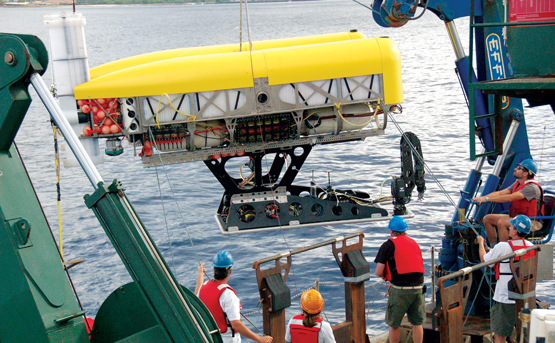Yancey assists "The Terminator" director in a daring ocean dive

The remotely operated submarine called Nereus undergoes testing near Hawaii in 2007.
When James Cameron, the self-proclaimed “King of the World” and director of the blockbuster films “Titanic” and “Avatar,” decides to dive to the deepest spot in the ocean, who does his scientist call for guidance?
Whitman biology Prof. Paul Yancey.
“I was in email contact with Cameron’s chief scientist during Cameron's dives,” said the Carl E. Peterson Endowed Chair of Sciences.
“He got specimens for me from the trench near New Guinea (Cameron's test dive), but none from the Mariana as he aborted his dive early,” Yancey said.

Professor Paul Yancey
The biology professor emphasized that he advised Cameron’s scientist what specimens to sample and how to take and preserve tissues.
Cameron’s epic adventure broke the record for a solo dive as his “vertical torpedo” sub dove to the Mariana Trench’s Challenger Deep – the deepest spot on Earth. The filmmaker’s scientist consulted with Yancey because he is an expert on the ecosystems of Hadal Trenches, the ocean’s deepest trenches.
Yancey was also consulted because he is scheduled to navigate a Remotely Operated Vehicle to the bottom of the Mariana Trench, 36,000 feet below the surface of the sea. The ROV is called Nereus, and Yancey will dive the sub to Challenger Deep in 2013.
(An account of Yancey’s expedition, Project Hades, can be found in the March 2012 issue of Whitman Magazine under the headline Secrets of the Deep.)
After a two and a half hour descent, Cameron spent about three hours at the bottom of the Mariana Trench. The filmmaker reported the sea floor to be a barren moonscape, a bleak, celestial nothingness. These observations don’t come as a surprise to Yancey.
“He seemed very surprised that it was a lifeless desert,” Yancey said. “We could have told him that, as Nereus did an initial survey in 2009. That is a key reason we are going to the Kermadec Trench (north of New Zealand) first, as it has a much greater food supply, much more life and probably more new species to find.”
Some suggest Cameron’s deep-sea adventure is nothing more than a publicity stunt to promote the forthcoming 3-D release of the Oscar-winning film “Titanic.”
So what does Yancey think about a wealthy celebrity hiring the world’s top engineers to construct a one-man sub capable of descending to the bone-crushing depths at the bottom of the sea?
“It will excite public interest in the deep sea,” Yancey said. “A manned presence is very useful, but we need all types of exploratory devices. such as landers and Nereus-type ROVS that can stay down much longer.
“These types of dives can help in the stewardship of the seas.”
By Edward Weinman